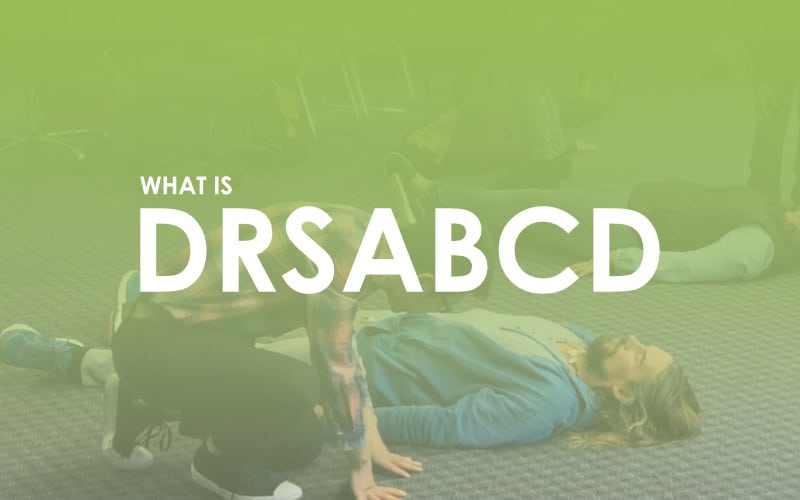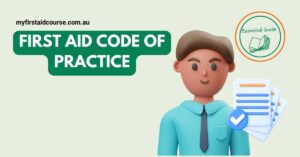
Cheap First Aid Courses? Get Quality Training at Affordable Prices
In this economy, money matters. When it comes to first aid training, no doubt you want to find a cheap course. But you’re mindful of

When you’re faced with a first aid emergency, the ability to act quickly and effectively can literally mean the difference between life and death. That means you’re going to need a plan — one you can remember and execute quickly and easily, that enables you to do the most good possible for anyone and everyone in need, without overstepping your skills or putting yourself in danger.
This is where the DRSABCD acronym comes in.
DRSABCD is an amazing and easy-to-remember tool that simply walks you through the vital steps needed in these high-stress situations. Developed by first aid experts across the globe, it’s become the most widely recognised and endorsed approach for managing emergencies.
In this article, we’re going to break down what DRSABCD stands for and how you can use it to handle first aid emergencies like a pro, whether you’re new to first aid or a seasoned first aider looking to refresh your knowledge.
At My First Aid Course, home to the most convenient and highly-rated first aid and CPR training courses in Brisbane, our goal is to empower you with the knowledge and skills needed to make a difference when it truly counts.
So, let’s dive right into the world of DRSABCD and uncover how this straightforward acronym can become your secret weapon in times of crisis. With the right knowledge and skills in your arsenal, you’ll be ready to make a difference and even save lives.
Now that you know the significance of the DRSABCD acronym, let’s dive deeper into each element and understand how it helps you respond effectively to first aid emergencies.
DRSABCD stands for Danger, Response, Send for Help, Airway, Breathing, CPR, and Defibrillation. These represent the steps to be taken to provide basic life support including CPR in the event of a first aid emergency.
Let’s look at each step in more detail:
First things first, always ensure your safety, as well as the safety of the patient and any bystanders. Check the scene for hazards like fire, traffic, or electricity. Remember, you can’t help anyone if you become a casualty yourself.
Once the area is secure, assess the patient’s responsiveness by gently shaking their shoulders and asking if they are alright. If there’s no response, it’s time to move on to the next step.
Call for emergency medical assistance immediately. Provide clear information about your location and a description of the patient’s condition. The sooner help arrives, the better the chances of a positive outcome.
Check the patient’s airway for obstructions, such as the tongue, vomit, or foreign objects. If necessary, tilt the head back and lift the chin to open the airway, allowing the patient to breathe more easily.
Take five to ten seconds to observe the patient’s chest for any signs of breathing. If they aren’t breathing, it’s time to begin CPR.
Start cardiopulmonary resuscitation (CPR) by providing chest compressions, as well as rescue breaths if you’ve been trained, at a rate of 30:2 respectively. This helps maintain the flow of oxygenated blood to the patient’s vital organs, increasing their chances of survival until medical help arrives.
If available, use an Automated External Defibrillator (AED) as soon as possible. These life-saving devices detect a shockable heart rhythm and will provide an electric shock, helping to restore a normal rhythm in cases of cardiac arrest.
By mastering the DRSABCD acronym, you’ll be well-equipped to respond to a variety of first aid emergencies. Of course, there’s no substitute for hands-on training and experience, which is why we encourage you to explore the courses offered by My First Aid Course Brisbane.
Now that we’ve broken down the DRSABCD acronym and explained its significance, let’s explore how it can be applied in various emergency scenarios. This section will provide you with a better understanding of the versatility of the DRSABCD method and why it’s crucial to have this knowledge in your first aid toolkit.
In a choking scenario, the DRSABCD steps ensure you first confirm the safety of the surroundings, assess the patient’s responsiveness, and call for help. You can then proceed to clear the airway and perform appropriate first aid techniques, such as back blows or abdominal thrusts, to help the person.
If you encounter an unconscious person, DRSABCD guides you to check for danger, assess their responsiveness, and call for help. Ensuring the person’s airway is clear, monitoring their breathing, and initiating CPR if necessary are crucial steps in this scenario.
During a seizure, DRSABCD helps you maintain a safe environment, call for help, and monitor the patient’s airway and breathing. After the seizure subsides, you can position the person on their side, ensuring their airway remains open.
In the event of cardiac arrest, DRSABCD is invaluable in guiding you to assess the situation, call for help, and initiate CPR. The quick use of an AED could potentially save the person’s life.
For severe bleeding, DRSABCD ensures that you prioritize safety, call for help, and attend to the patient’s airway and breathing. You can then apply direct pressure to the wound, elevate the injured area, and utilize a pressure bandage to control the bleeding.
By understanding the application of DRSABCD in various emergency situations, you can see the importance of being well-versed in this life-saving acronym. However, to be truly prepared for emergencies, hands-on training is essential.
My First Aid Course Brisbane offers comprehensive, top-rated, and convenient first aid and CPR training courses that will equip you with the practical skills and knowledge required to make a real difference in emergency situations. By investing in your first aid education, you’re not only empowering yourself but also contributing to the safety and well-being of those around you.
To sum up, DRSABCD—Danger, Response, Send for help, Airway, Breathing, CPR, and Defibrillator—is your lifeline in first aid emergencies. This acronym, your guide to action, is an absolute game-changer when time is of the essence.
But don’t stop here.
Elevate your readiness with hands-on training and get certified as a bona fide first aider. Dive into one of My First Aid Course Brisbane’s top-rated, ultra-convenient courses. Book and learn online at your pace, then hone your skills in a short, practical session in Brisbane. Join us and you could become the difference between life and death—because in first aid, every second matters. Make those seconds count.
If you prefer to talk to someone or want other payment options, call and talk to one of our friendly staff on 07 3872 6777.
Get in touch today!

In this economy, money matters. When it comes to first aid training, no doubt you want to find a cheap course. But you’re mindful of

Picture this – you’re out on a wilderness adventure, miles from civilization, when suddenly someone in your group gets injured. What do you do? Panic?

Welcome to your ultimate guide on the first aid code of practice in Queensland! Whether you’re a business owner, an organisation, or an employee, understanding